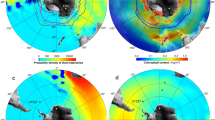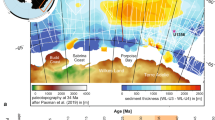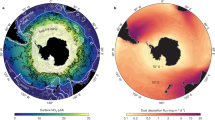Abstract
Productivity in the Pleistocene glacial Southern Ocean was probably enhanced owing to iron fertilization by aeolian dust. Marine sediments indicate such an increase north of the modern Antarctic Polar Front but reduced biogenic activity south of it. However, quantitative estimates for the integrated net effect are difficult to obtain. Here we use the SO42− isotopic composition and other geochemical ice core records from the Atlantic sector of the Southern Ocean to reconstruct net changes in integrated biogenic sulfur productivity in the surface ocean over the penultimate glacial termination. We show that biogenic SO42− aerosol contributes 58% and 85% to the sulfate budget in Dronning Maud Land during glacial and interglacial times, respectively, and that biogenic sulfate is derived predominately from the seasonal sea ice zone. Using our quantitative reconstruction of biogenic aerosol production in the Southern Ocean source region, we show that the average biogenic sulfate production integrated over the Atlantic sector was 16% higher in the penultimate glacial 137,000–153,000 years ago compared with the later Last Interglacial 120,000–125,000 years ago. An intermittent decrease in productivity observed during early peak interglacial warming suggests that a reduction in the seasonal sea ice zone may disrupt Southern Ocean ecosystems.
This is a preview of subscription content, access via your institution
Access options
Access Nature and 54 other Nature Portfolio journals
Get Nature+, our best-value online-access subscription
$32.99 / 30 days
cancel any time
Subscribe to this journal
Receive 12 print issues and online access
$259.00 per year
only $21.58 per issue
Buy this article
- Purchase on SpringerLink
- Instant access to full article PDF
Prices may be subject to local taxes which are calculated during checkout





Similar content being viewed by others
Data availability
EDML and B38 ice core data and derived quantities can be found in Supplementary Table 1 and are available via Zenodo at https://doi.org/10.5281/zenodo.14199069 (ref. 58).
Code availability
Data evaluation is based on simple MATLAB code, which is available on request from the corresponding author.
References
Lüthi, D. et al. High-resolution carbon dioxide concentration record 650,000–800,000 years before present. Nature 453, 379–382 (2008).
Köhler, P. & Fischer, H. Simulating low frequency changes in atmospheric CO2 during the last 740,000 years. Climate 2, 57–78 (2006).
Martin, J. Glacial–interglacial CO2 change: the iron hypothesis. Paleoceanogr. Paleoclimatol. 5, 1–13 (1990).
Wolff, E. W. et al. Southern Ocean sea ice, DMS production and iron flux over the last eight glacial cycles. Nature 440, 491–496 (2006).
Lambert, F. et al. Dust–climate couplings over the past 800,000 years from the EPICA Dome C ice core. Nature 452, 616–619 (2008).
Martinez-Garcia, A. et al. Southern Ocean dust–climate coupling over the past four million years. Nature 476, 312–315 (2011).
Kohfeld, K. E., LeQuéré, C., Harrison, S. P. & Anderson, R. F. Role of marine biology in glacial–interglacial CO2 cycles. Science 308, 74–78 (2005).
Jaccard, S. L. et al. Two modes of change in Southern Ocean productivity over the past million years. Science 339, 1419–1423 (2013).
Wang, X. T. et al. Deep-sea coral evidence for lower Southern Ocean surface nitrate concentrations during the last ice age. Proc. Natl Acad. Sci. USA 114, 3352–3357 (2017).
Studer, A. S. et al. Antarctic Zone nutrient conditions during the last two glacial cycles. Paleoceanogr. Paleoclimatol. 30, 845–862 (2015).
Wolff, E. W. et al. Changes in environment over the last 800,000 years from chemical analysis of the EPICA Dome C ice core. Quat. Sci. Rev. 29, 285–295 (2010).
Kaufmann, P. et al. Ammonium and non-sea-salt sulfate in the EPICA ice cores as indicator of biological activity in the Southern Ocean. Quat. Sci. Rev. 29, 313–323 (2010).
Alexander, B. et al. East Antarctic ice core sulfur isotope measurements over a complete glacial-interglacial cycle. J. Geophys. Res. https://doi.org/10.1029/2003JD003513 (2003).
Ishino, S. et al. Homogeneous sulfur isotope signature in East Antarctica and implication for sulfur source shifts through the last glacial–interglacial cycle. Sci. Rep. 9, 12378 (2019).
Legrand, M. et al. Year-round record of bulk and size-segregated aerosol composition in central Antarctica (Concordia site)—part 2: biogenic sulfur (sulfate and methanesulfonate) aerosol. Atmos. Chem. Phys. 17, 14055–14073 (2017).
Wagenbach, D. et al. Sea-salt aerosol in coastal Antarctic regions. J. Geophys. Res. 103, 10961–10974 (1998).
Yang, X., Pyle, J. A. & Cox, R. A. Sea salt aerosol production and bromine release: role of snow on sea ice. Geophys. Res. Lett. 35, L16815 (2008).
Wegner, A. et al. Change in dust variability in the Atlantic sector of Antarctica at the end of the last deglaciation. Climate 8, 135–147 (2012).
Delmonte, B. et al. Aeolian dust in the Talos Dome ice core (East Antarctica, Pacific/Ross Sea sector): Victoria Land versus remote sources over the last two climate cycles. J. Quat. Sci. 25, 1327–1337 (2010).
Bigler, M., Röthlisberger, R., Lambert, F., Stocker, T. F. & Wagenbach, D. Aerosol deposited in East Antarctica over the last glacial cycle: detailed apportionment of continental and sea-salt contributions. J. Geophys. Res. https://doi.org/10.1029/2005JD006469 (2006).
Goto-Azuma, K. et al. Reduced marine phytoplankton sulphur emissions in the Southern Ocean during the past seven glacials. Nat. Commun. 10, 3247 (2019).
Bowen, H. J. M. Environmental Chemistry of the Elements (Academic Press, 1979).
Uemura, R. et al. Soluble salts in deserts as a source of sulfate aerosols in an Antarctic ice core during the last glacial period. Earth Planet. Sci. Lett. 578, 117299 (2022).
Rees, C. E., Jenkins, W. J. & Monster, J. The sulphur isotopic composition of ocean water sulphate. Geochim. Cosmochim. Acta 42, 377–381 (1978).
Doyle, E. A. Implementing a New Method to Measure δ34SO4 in Ice Cores to Assess Sulfate Sources in West Antarctica. PhD thesis, Univ. Cambridge (2021).
Rech, J. A., Quade, J. & Hart, W. S. Isotopic evidence for the source of Ca and S in soil gypsum, anhydrite and calcite in the Atacama Desert, Chile. Geochim. Cosmochim. Acta 67, 575–586 (2003).
Klipsch, S. et al. Sulfate sources, biologic cycling, and mobility in Atacama Desert soils revealed by isotope signatures. Glob. Planet. Change 230, 104290 (2023).
Burke, A. et al. Sulfur isotopes in rivers: insights into global weathering budgets, pyrite oxidation, and the modern sulfur cycle. Earth Planet. Sci. Lett. 496, 168–177 (2018).
Jonsell, U., Hansson, M. E., Mörth, C.-M. & Torssander, P. Sulfur isotopic signals in two shallow ice cores from Dronning Maud Land, Antarctica. Tellus B 57, 341–350 (2005).
Patris, N., Delmas, R. J. & Jouzel, J. Isotopic signatures of sulfur in shallow Antarctic ice cores. J. Geophys. Res. 105, 7071–7078 (2000).
Jongebloed, U. A. et al. Underestimated passive volcanic sulfur degassing implies overestimated anthropogenic aerosol forcing. Geophys. Res. Lett. 50, e2022GL102061 (2023).
Köhler, P., Fischer, H., Schmitt, J. & Munhoven, G. On the application and interpretation of Keeling plots in paleo climate research—deciphering δ13C of atmospheric CO2 measured in ice cores. Biogeosciences 3, 539–356 (2006).
Wolff, E. W. et al. Frequency of large volcanic eruptions over the past 200,000 years. Clim. Past 19, 23–33 (2023).
Huybers, P. & Langmuir, C. Feedback between deglaciation, volcanism, and atmospheric CO2. Earth Planet. Sci. Lett. 286, 479–491 (2009).
Markle, B. R., Steig, E. J., Roe, G. H., Winckler, G. & McConnell, J. R. Concomitant variability in high-latitude aerosols, water isotopes and the hydrologic cycle. Nat. Geosci. 11, 853–859 (2018).
EPICA Community Members. One-to-one coupling of glacial climate variability in Greenland and Antarctica. Nature 444, 195–198 (2006).
Hulswar, S. et al. Third revision of the global surface seawater dimethyl sulfide climatology (DMS-Rev3). Earth Syst. Sci. Data 14, 2963–2987 (2022).
Chandler, D. & Langebroek, P. Southern Ocean sea surface temperature synthesis: part 2. Penultimate glacial and last interglacial. Quat. Sci. Rev. 271, 107190 (2021).
Markle, B. R. & Steig, E. J. Improving temperature reconstructions from ice-core water–isotope records. Clim. Past 18, 1321–1368 (2022).
Weller, R. et al. Continuous 25-yr aerosol records at coastal Antarctica—I: inter-annual variability of ionic compounds and links to climate indices. Tellus B 63, 901–919 (2011).
Deppeler, S. L. & Davidson, A. T. Southern Ocean phytoplankton in a changing climate. Front. Mar. Sci. 4, 40 (2017).
Chadwick, M., Allen, C. S., Sime, L. C., Crosta, X. & Hillenbrand, C. D. Reconstructing Antarctic winter sea-ice extent during Marine Isotope Stage 5e. Clim. Past 18, 129–146 (2022).
Hayes, C. T. et al. A stagnation event in the deep South Atlantic during the last interglacial period. Science 346, 1514–1517 (2014).
Schneider Mor, A. et al. Variable sequence of events during the past seven terminations in two deep-sea cores from the Southern Ocean. Quat. Res. 77, 317–325 (2012).
Li, Q., England, M. H., Hogg, A. M., Rintoul, S. R. & Morrison, A. K. Abyssal ocean overturning slowdown and warming driven by Antarctic meltwater. Nature 615, 841–847 (2023).
Reijmer, C. H., van den Broeke, M. R. & Scheele, M. P. Air parcel trajectories and snowfall related to five deep drilling locations in Antarctica based on the ERA-15 dataset. J. Clim. 15, 1957–1968 (2002).
Bouchet, M. et al. The Antarctic Ice Core Chronology 2023 (AICC2023) chronological framework and associated timescale for the European Project for Ice Coring in Antarctica (EPICA) Dome C ice core. Clim. Past 19, 2257–2286 (2023).
Martínez-Garcia, A. et al. Links between iron supply, marine productivity, sea surface temperature, and CO2 over the last 1.1 Ma. Paleoceanogr. Paleoclimatol. 24, PA1207 (2009).
Bonn, W. J., Gingele, F. X., Grobe, H., Mackensen, A. & Fütterer, D. K. Palaeoproductivity at the Antarctic continental margin: opal and barium records for the last 400 ka. Palaeogeogr. Palaeoclimatol. Palaeoecol. 139, 195–211 (1998).
Fernandoy, F. et al. Temporal and spatial variation of stable-isotope ratios and accumulation rates in the hinterland of Neumayer station, East Antarctica. J. Glaciol. 56, 673–687 (2010).
Burke, A. et al. Stratospheric eruptions from tropical and extra-tropical volcanoes constrained using high-resolution sulfur isotopes in ice cores. Earth Planet. Sci. Lett. 521, 113–119 (2019).
Paris, G., Sessions, A. L., Subhas, A. V. & Adkins, J. F. MC-ICP-MS measurement of δ34S and ∆33S in small amounts of dissolved sulfate. Chem. Geol. 345, 50–61 (2013).
Kaufmann, P. et al. An improved continuous flow analysis (CFA) system for high-resolution field measurements on ice cores. Environ. Sci. Technol. 42, 8044–8050 (2008).
Röthlisberger, R. et al. Technique for continuous high-resolution analysis of trace substances in firn and ice cores. Environ. Sci. Technol. 34, 338–342 (2000).
Erhardt, T. et al. High-resolution aerosol concentration data from the Greenland NorthGRIP and NEEM deep ice cores. Earth Syst. Sci. Data 14, 1215–1231 (2022).
Gfeller, G. et al. Representativeness of major ions measurements and seasonality derived from NEEM firn cores. Cryosphere 8, 1855–1870 (2014).
Severi, M., Becagli, S., Traversi, R. & Udisti, R. Recovering paleo-records from Antarctic ice-cores by coupling a continuous melting device and fast ion chromatography. Anal. Chem. 87, 11441–11447 (2015).
Fischer, H. et al. Sulfate isotope and geochemical ice core data from Dronning Maud Land over the penultimate glacial termination. Zenodo https://doi.org/10.5281/zenodo.14199069 (2024).
Acknowledgements
H.F. gratefully acknowledges the financial support by the Swiss National Science Foundation (grant nos. 200020_172506 and 200020B_200328) and sabbatical support by the University of St Andrews in 2022. This work is a contribution to the European Project for Ice Coring in Antarctica (EPICA), a joint European Science Foundation/European Commission scientific programme, funded by the EU (EPICA-MIS) and by national contributions from Belgium, Denmark, France, Germany, Italy, the Netherlands, Norway, Sweden, Switzerland and the UK. The main logistic support was provided by Institut Polaire Français Paul-Émile Victor and Programma Nazionale di Ricerche in Antartide (at Dome C) and Alfred-Wegener-Institut, Helmholtz-Zentrum für Polar- und Meeresforschung (at Dronning Maud Land). This is EPICA publication no. 323.
Author information
Authors and Affiliations
Contributions
H.F. and A.B. designed the project. Ice core samples for sulfate isotope measurements were prepared by H.F. at AWI with the help of T.E., B.T., M.H. and J.F. Sulfur isotope analyses and quality control were performed at St Andrews by A.B., J.R. and P.J.S. Published aerosol chemical data were measured at University of Bern, AWI and University of Florence. EDML high-resolution sulfate data were provided by M.S. The initial aerosol transport model was provided by B.M. and revised by H.F. B.M. performed the source area analysis to constrain biogenic sulfate source temperatures. Data analysis was performed by H.F. with input by A.B., J.R., T.E., B.M., H.P. and E.W. The paper was written by H.F. with substantial support by all co-authors.
Corresponding author
Ethics declarations
Competing interests
The authors declare no competing interests.
Peer review
Peer review information
Nature Geoscience thanks Ann-Lise Norman and the other, anonymous, reviewer(s) for their contribution to the peer review of this work. Primary Handling Editor: James Super, in collaboration with the Nature Geoscience team.
Additional information
Publisher’s note Springer Nature remains neutral with regard to jurisdictional claims in published maps and institutional affiliations.
Supplementary information
Supplementary Information
Supplementary Discussion, Figs. 1–8 and Table 1.
Supplementary Table 1
Ice core data and derived quantities.
Rights and permissions
Springer Nature or its licensor (e.g. a society or other partner) holds exclusive rights to this article under a publishing agreement with the author(s) or other rightsholder(s); author self-archiving of the accepted manuscript version of this article is solely governed by the terms of such publishing agreement and applicable law.
About this article
Cite this article
Fischer, H., Burke, A., Rae, J. et al. Limited decrease of Southern Ocean sulfur productivity across the penultimate termination. Nat. Geosci. 18, 160–166 (2025). https://doi.org/10.1038/s41561-024-01619-7
Received:
Accepted:
Published:
Issue date:
DOI: https://doi.org/10.1038/s41561-024-01619-7



